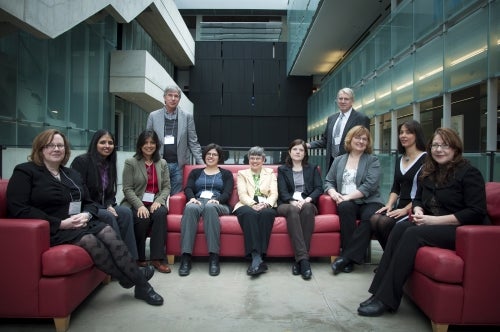Science and Technology in Society
J.G. Hagey Hall of the Humanities (HH), room 365
Tel: (519) 888-4567 x31386
The second annual Science and Technology in Society Day, "Women in Physics: Past, Present, and Future" was a great success !

The Second Annual Science and Technology in Society Day celebrated International Women’s Day with a truly stellar event, featuring one of the foremost scientists in the world. One might be forgiven for describing Adriana Ocampo—NASA’s Program Executive for the Science Mission Directorate, and lead scientist for US, European and Japanese exploration projects on Venus—as a great woman scientist, but such a qualifier is entirely beside the point. And that was sort of the point of the event.
Women and Physics: Past, Present, and Future, held at Perimeter Institute on March 8, 2013 brought together students and faculty from University of Waterloo and Laurier University to discuss the role of women in science, how that role has changed through history, and where the future will take it.
It’s important to understand that women’s role in society has changed dramatically in the last half-century, and in most fields, women have reached the highest levels of achievement.--Carla Fehr
Carla Fehr, is an associate professor of Philosophy and Wolfe Chair in Scientific and Technological Literacy at Waterloo.
The hard sciences is one of the places where women have found the most difficulty in breaking through the glass ceiling, so bringing a pre-eminent scientist—who happens to be a woman—who can share her experience in doing that is a real treat for faculty and students alike.--Carla Fehr
Ocampo’s path to top space scientist is quite usual, and not merely because of her gender. As a little girl in Argentina, she had a powerful curiosity about space. When her family emigrated to the United States, she channeled that curiosity into a volunteer job at a science center. With support and encouragement from her parents, she pursued an education in planetary geology and aerospace engineering.
Ocampo says that while in her career she frequently has been one of few women among her colleagues, NASA has been a welcoming place, with the gender of the scientist having far less impact on success than the quality of her ideas. But she says more needs to be done earlier in the education system to encourage girls that they can pursue careers in physics and other sciences, and succeed.
Dr. Fehr says that diversity isn’t good just because it’s good for women—it’s also good for science.
When you have people from diverse backgrounds, of different ethnicities and genders, they bring a variety of perspectives and opinions, and that leads to new ways of thinking. Questions get asked that might never have been considered before. Bringing ‘new eyes’ to a problem is harder to do in a homogenous group.--Carla Fehr
For the young women in the audience, Ocampo’s personal history had a familiar ring, as the percentage of women in science programs continues to be low. Neil Turok, director of the Perimeter Institute, says the number of women in physics has grown, but in the past decade it has leveled off at around 20 percent, which he calls “unacceptable.”
It’s bad for women, and it’s bad for physics.--Neil Turok
Improving on that record is a goal that will require commitment from every level of education, including the highest reaches of academia.
In my research, I’ve seen that when universities commit to welcoming women and valuing them as colleagues, it improves the work environment for men, as well. And that tends to create a better environment for students—again, men and women alike. And as young girls see more women succeed in the sciences, it will show them that they can follow those footsteps.--Carla Fehr
Adriana Ocampo in The Record: NASA scientist encourages women to reach for the stars




